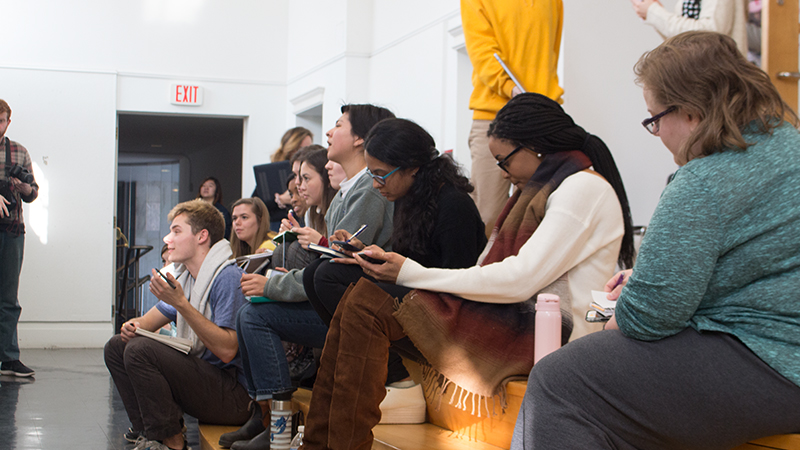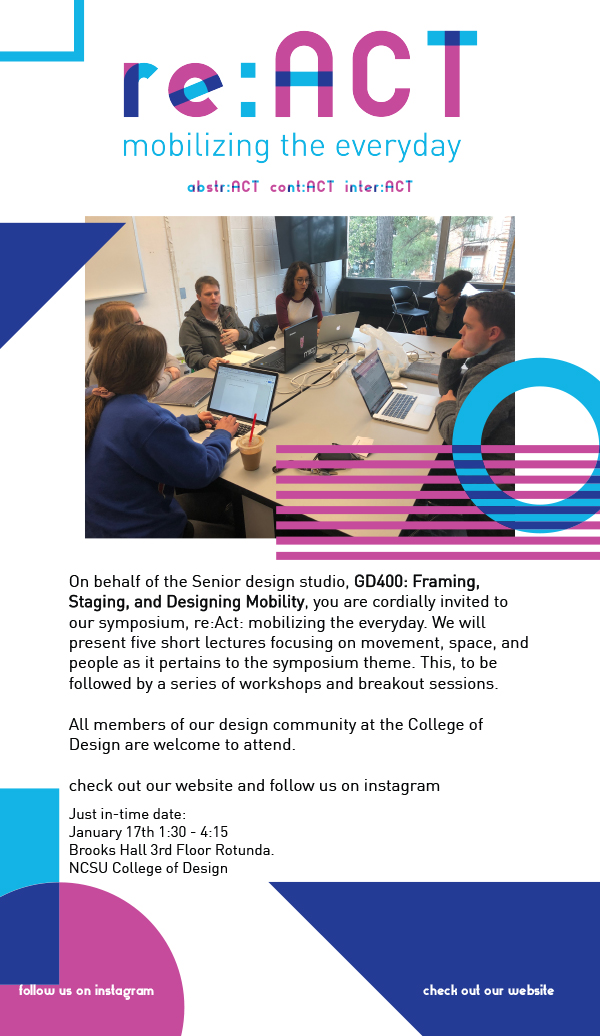Design on a Deadline


During the first week of class, students in Associate Professor of Graphic Design Kermit Bailey’s GD 400 studio were tasked with designing an experience that would introduce the complex issue of design mobilities to an audience of sophomore typography students. Unfamiliar with the topic themselves, Bailey’s students split into research groups and presented their findings to each other during their next class. By the end of the week, they had prepared, marketed, and produced the internal symposium of lectures and workshops they titled “ReAct, Mobilizing the Everyday.”
 The short timeline that students were given forced them out of their comfort zones and typical design processes. Kayla Watson, a senior in Bailey’s course, says the quick turnaround was a welcome challenge. “I’m definitely a planner… I like having time to iterate and go back and forth, but this time we didn’t have the opportunity to do that. And while I like doing what I usually do, this was a great way to dive in and be immersed in the experience.” Marcie Laird, also a senior in graphic design agrees, “I thought it was a really great activity on Kermit’s part because it really made us feel empowered in our knowledge… it was definitely a confidence boost to get up there and talk about this research in front of underclassmen but also graduate students and some faculty members.”
The short timeline that students were given forced them out of their comfort zones and typical design processes. Kayla Watson, a senior in Bailey’s course, says the quick turnaround was a welcome challenge. “I’m definitely a planner… I like having time to iterate and go back and forth, but this time we didn’t have the opportunity to do that. And while I like doing what I usually do, this was a great way to dive in and be immersed in the experience.” Marcie Laird, also a senior in graphic design agrees, “I thought it was a really great activity on Kermit’s part because it really made us feel empowered in our knowledge… it was definitely a confidence boost to get up there and talk about this research in front of underclassmen but also graduate students and some faculty members.”
The studio shows how graphic designers are increasingly being called on to facilitate communication and interaction, especially between disciplines. Laird explains, “I think that we’re witnessing a moment in the design world where we’re re-evaluating our role in terms of work and the role of people of other disciplines. There’s definitely a shift towards this interdisciplinary thinking, and the fact that we as a senior graphic design studio were introduced to this sociological theory kind of speaks to that. We can kind of bridge the gap between all these different things and work towards a common goal.”
After just the first weeks of class, Laird and Watson were already experiencing a shift in the way they viewed design. Laird says, “one of the big takeaways of thinking about mobilities is this understanding that our built environment has meaning and the way that we move through it has meaning in the context of being human… I think it is really important because it helps you take into account perspectives other than your own and make more appropriate and useful design.”
The symposium not only helped the GD 400 students quickly grasp the concept of design mobililites, but Watson says that sophomore students in the audience reported having a better understanding of mobilities afterwards.
“I’m still in awe that we were able to not only create lectures and workshops but also the presentation. Everyone did a good job; everyone’s hand was in it. It’s a nice moment… we spent four years together, and this is what we can do if we all put our minds together. It’s really fun to see how that panned out. —Kayla Watson
Staci Kleinmaier is a professional writer and photographer in Apex, North Carolina. She uses words and images to tell stories. To see her work, visit www.stacikleinmaier.com.
- Categories:



